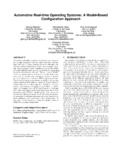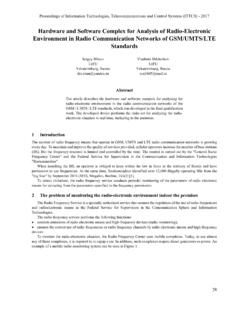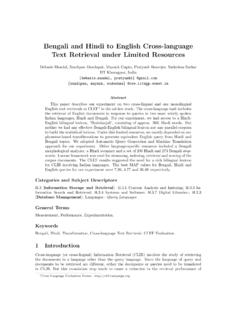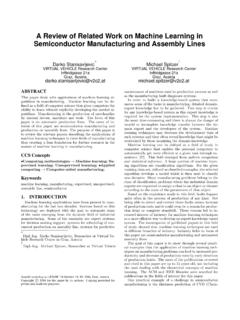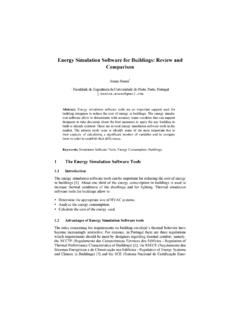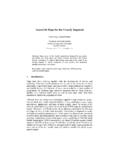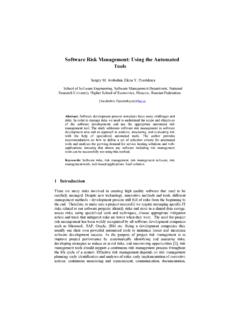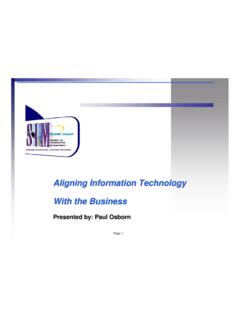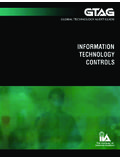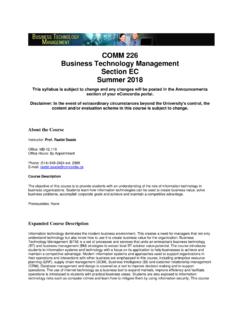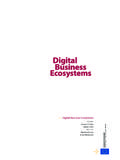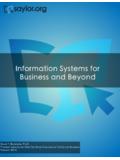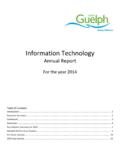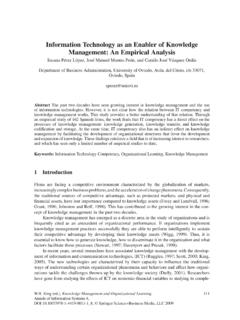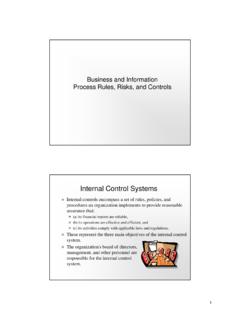Transcription of Inter-Organizational Business Processes Modelling …
1 Inter-Organizational Business Processes Modelling framework Khoutir Bouchbout, Zaia Alimazighi Computer Science Department, USTHB University, Algiers, Algeria Abstract. An Interorganizational Business Process (IOBP) is an organized group of joined activities carried out by two or more organizations to achieve a common Business objective. A consequence of this is that Business process Modelling and design used inside an organization have to be enhanced and extended to cope with interorganizational Business particularities. Thus, methods are required to describe and automate interorganizational Business Processes in an efficient manner. Modelling IOBP involves new challenges, mainly the ability to cope with autonomy, privacy, heterogeneity, and the support for coordination trough mutual agreements. As a contribution to this area, this paper proposes a framework for IOBP Modelling based on MDA approach which relies on the principles of SOA.
2 Thus, the framework consider three levels in a top-down manner: Business ( organizational ), conceptual (logic) and technical (execution). Keywords: Interorganizational Business process, Business process Modelling , interorganizational Business process metamodel, MDA-based framework , e-procurement. 1 Introduction The growing importance of cooperation is a result of globalization in combination with the disappearance of political borders and above all technological advances caused mainly by the Internet. Collaboration between companies like in supply chains are considered necessary in a Business environment, where companies focus on their competitive advantage, perform only those functions for which they have expert skills and they complement their offering through partners and suppliers [3]. Thus, the need for connecting information systems of collaborating organizations has become increasingly common.
3 To achieve this, Interorganizational Information Systems (IOS) is needed to facilitate interoperation of disparate information systems of different organizations. One way of facilitating IOS deployment with less implementation effort for each e- Business partner, is to apply e- Business frameworks that provide standards and specifications enabling businesses to communicate efficiently over the Internet. Significant advantages, such as increased speed, efficiency, and reliability, can be obtained by automating IOBP. IOBP are the enabler of such Business environments. The design and implementation of inter -enterprise information systems involves the fulfilment of particular: the flexibility and ability to cope with change, decentralized management of IOBP, peer-to-peer interactions, preservation of enterprises autonomy and privacy, and the required support for interoperability. In this paper, we discuss the consequences of interorganizational relationships for the Business process Modelling architecture of the participating enterprises.
4 Though, we conduct explorative research which is considered appropriate for analyzing particularities of interorganizational Processes in comparison with internal Processes . Having achieved this task, we present our MDA-based framework for IOBP Modelling . The remainder of the paper is structured as follows. In section 2, we cover the basic concepts of IOBP. In section 3, we explain, in detail, the aspects of the proposed generic IOBP metamodel. Subsequently, the section 4 describes the proposed IOBP Modelling framework with its phases. The section 5 describes the implementation of the proposed architecture. Finally, the paper finishes giving a summary and an outlook to future work. 2 Basic Concepts of Interorganizational Business Processes Business process is defined as a flow of related activities that together create a customer value [8]. A typical high-level Business process describes the means by which the organization provides value to its customers, regardless of the function of individual departments.
5 Particularities of Interorganizational Business Processes Before Modelling IOBP, It is necessary to analyze the characteristics of IOBP in comparison with internal private (intra- organizational ) Processes . While intra- organizational Processes comprise activities executed inside one organization only, the activities comprised in an IOBP are executed by different organizations that are working together to reach a common objective ([11], [26]). IOBP need close coordination among networking partners. In order to illustrate the IOBP concepts, we regularly refer to the following corporate procurement process example scenario depicted by the Figure 1 (Private process in grey and public process in white). The procurement application concerns two trading partners a buyer and a seller which are collaborating and need to network their Business Processes . Each of the participants has his internal Business Processes that are of different platform nature.
6 For more details about this example we can refer to [3]. An example of an IOBP: collaborative, public & private Processes Receiverequestfor quoteSendrequestfor quoteSendquoteinfo/rejectionSendpurchase orderReceivequoteinfo/rejectionReceivepu rchaseorderSendorderAcceptat/rejectionRe ceiveorderacceptat/rejectionCollaboProce ss(global)Sendrequestfor quoteSendpurchaseorderReceivequoteinfo/r ejectionReceiveorderacceptat/rejectionBu yerProcessSellerProcessCan notbeproducedGetproductinfoReceivereques tfor quoteCheckproductcatalogGetstockinfoCalc ulateproductpriceSendquoteinfo/rejection ReceivePurchaseorderCheckcustomercredibi litySendorderAcceptat/rejectionFinancial approvalReceiverequestfor quoteSendrequestfor quoteSendquoteinfo/rejectionSendpurchase orderReceivequoteinfo/rejectionReceivepu rchaseorderSendorderAcceptat/rejectionRe ceiveorderacceptat/rejectionCollaboProce ss(global)Sendrequestfor quoteSendpurchaseorderReceivequoteinfo/r ejectionReceiveorderacceptat/rejectionBu yerProcessSellerProcessCan notbeproducedGetproductinfoReceivereques tfor quoteCheckproductcatalogGetstockinfoCalc ulateproductpriceSendquoteinfo/rejection ReceivePurchaseorderCheckcustomercredibi litySendorderAcceptat/rejectionFinancial approval Important research approaches to handling the specifics of IOBP come from approaches for workflow management, ([1],[3],[5],[11],[14],[16],[20],[26],[2 8]), current extensions of process Modelling ([2],[24],[29], [31]), and B2B standards [18], but has been limited to the process layer so far.
7 They consider a process described either as a Private (orchestration, internal or executable), Public (local choreography, abstract or view), and Collaborative (global choreography, cross- organizational or interorganizational) in order to better separate the information density of different areas of concern. To explain specifics of IOBP Modelling , we will discuss their requirements and particularities [3]. Decentralized governance of the global process. There is no entity that designs, implements, executes, and monitors the end-to-end process [15]. This requirement follows the assumption that central governance reduces the autonomy of the parties and may require visibility to details that are not necessarily visible in a distributed process. Need for Internal information privacy. In interorganizational environments the internal Business Processes are one key competence of the organizations they want to preserve from the other organizations.
8 In order to support these requirements, a flexible information hiding mechanism is required. The information provided to participate in an IOBP should not necessarily allow conclusion to the participant s internal realization of the functionality. Autonomy preservation of Business partners. An IOBP assumes that each participating Business in a B2B transaction is autonomous, that is, it is able to decide the conditions of the interactions, , when, how and with whom. Each partner has a full autonomy to design, implement, execute and monitor its internal Processes , provided they comply with the partner's obligations toward the other partners [18]. The IOBP participants act autonomously and must coordinate themselves by means of interactions. Interactions between Business partners. This is achieved via interactions flow (message and information exchanges) for connecting Business partners.
9 Overview of the Current Business Process Modelling Languages The origins of Business process Modelling (BPM) languages are quite diverse. Surveys comparing different types of Business process Modelling languages are provided in ([3], [8], [17], [18], [19]). Some approaches are mainly used in the requirements specification phase to support the communication with Business domain experts. Resulting models are usually on a rather abstract level and tend to hide implementation complexity. Other approaches are more implementation oriented and sometimes seem to be a reverse engineered graphical notation of workflow languages or of Web Services orchestrations and choreographies [29]. The approaches investigated introduce a representation of the interorganizational Business process, which uses either an existing Modelling notation (UML2 Activity Diagrams [30], EPC [25] or BPMN [21]) or its extensions. Specific artefacts are necessary for describing IOBP, among them external organizations, roles or partner types as well as messages, Business documents and channels.
10 Although there is abundance of BPM languages and despite their diversity, only a few were applicable for IOBP Modelling in practical cases. In other words, there is no single language which fulfils all requirements identified for specifying IOBP, such as: enterprise autonomy, decentralized process owner, peer-to-peer interactions and collaborations. Thus, in this section we analyze and compare the Modelling languages UMM (UN/CEFACT Modelling Methodology) [13], EPC (ARIS), UML2 AD, and BPMN. Furthermore, UML2 Activity Diagrams, EPC and BPMN are more suitable to model public or private Processes from the viewpoint of one partner instead of showing the peer-to-peer interactions between the partners as a whole. Although BPMN allows the definition of IOBP by representing the message exchange among public Processes of the partners (BPMN pools), it does not provide the semantics to describe the dependencies of the global control flow of the message exchange.

